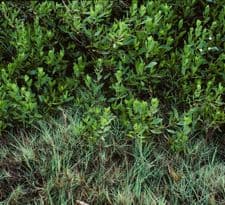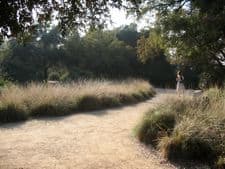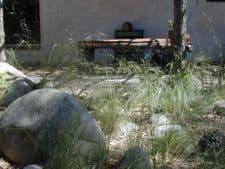| Basic Plant Information |
Comments and Picture – Click on images to see larger format or more
|
| Plant name |
Achnatherum coronatum |
| Common |
Giant Needle Grass |
| Size (H x W) |
6 x 3 |
| Growth Season |
Cool |
| Flower |
Spring, seed heads remain upright for months |
| Synonyms |
Stipa coronata |
|
Occurs naturally in full sun on dry gravelly rocky often sloping ground in chaparral at elevations up to 5000′ in southwestern CA and adjacent Mexico. Well-suited to sunny, dry sites.
CalPhotos Images of Achnatherum coronatum
|
| Plant name |
Agrostis pallens |
| Common |
San Diego Bent Grass |
| Size (H x W) |
|
| Growth Season |
Cool
|
| Flower |
Spring, delicate seed heads add lovely movement to the garden |
| Synonyms |
A. diegoensis |
|
Adapted to shady woodlands in the mountains and foothills and open, north-facing meadows along the coast from San Diego to Sonoma. Sought after for quick, even growth, lawn candidate with some irrigation.
CalPhotos Images of Agrostis pallens
|
| Plant name |
Aristida purpurea
|
| Common |
Purple Three-Awn |
| Size (H x W) |
|
| Growth Season |
Cool
|
| Flower |
Spring, delicate seed heads add lovely movement to the garden |
|
Attractive year-round, purple three-awn is uniquely colorful when flowering. The inflorescenses are strongly red-purple at first bleaching in the sun to light straw color.

|
| Plant name |
Bouteloua gracilis |
| Common |
Blue Grama |
| Size (H x W) |
1 x 1 |
| Growth Season |
Warm
|
| Flower |
Summer, showy flowers like eyelashes or pennants |
| Synonyms |
B. oligostachya |
|
Low growing species is native to a vast majority of the US, growing in the hottest, driest parts. Semi-evergreen – cool weather shuts off growth, but dormancy is brief in mild climates. Lawn candidate.

|
| Plant Name |
Deschampsia caespitosa |
| Common |
Tufted Hairgrass |
| Size (H x W) |
1 x 1 |
| Growth Season |
Cool
|
| Flower |
Spring, seedheads remain through summer |
|
Medium sized, densely tufted, coarse bunchgrass. It grows in moist meadows of the higher mountains in California and along the coast as far south as Santa Barbara. Good for a wetter spot in the garden or can thrive planted as a lawn with some irrigation.

|
| Plant name |
Distichlis spicata |
| Common |
Salt Grass |
| Size (H x W) |
|
| Growth Season |
Warm
|
| Flower |
Inconspicuous |
|
As the name implies, a very salt tolerant, creeping grass native to coastal and low desert regions in California, in generally salty conditions. Soil stabilizing, resilient and tenacious.

|
| Plant name |
Elymus glaucus |
| Common |
Blue Wild Rye
|
| Size (H x W) |
2-4 x 5+
|
| Growth Season |
Cool
|
| Flower |
Summer |
|
Spreading cool season grass, great groundcover, soil stabilizer.
CalPhotos Images of Elymus glaucus |
| Plant name |
Festuca californica
|
| Common |
California Fescue |
| Size (H x W) |
2-3 x 2
|
| Growth Season |
Cool
|
| Flower |
Spring, airy and decorative 1-2′ above foliage |
|
Robust medium bunchgrass with glaucus evergreen foliage associated with brushlands and deciduous oak forests. Excellent grass for shady or filtered light settings, airy flowers add nice contrast.

|
| Plant name |
Festuca rubra ‘Patrick’s Point’ |
| Common |
Creeping Red Fescue |
| Size (H x W) |
3 x 3
|
| Growth Season |
Cool
|
| Flower |
Spring |
|
Medium-sized loosely tufted, fine leafed grass that spreads slowly by underground rhizomes. This very blue selection of F. rubra is from the north coast; the species is found as far south as Big Sur. Requires irrigation, prefers richer soils in southern California. An excellent, durable alternative to European Blue Fescue and Blue Oat Grass.
 |
| Plant name |
Leymus condensatus
|
| Common |
Giant Wild Rye |
| Size (H x W) |
4-8 x 6
|
| Growth Season |
Cool
|
| Flower |
Summer, large and tall flower stalks, tan |
| Synonyms |
Elymus condensatus |
|
Large, very tough, drought tolerant grass. Native to slopes and ravines, this grass tolerates heavy soil and drought. Spreads slowly from rhizome. Strong candidate to cover large areas with little water.

|
| Plant name |
Leymus condensatus ‘Canyon Prince’ |
| Common |
Canyon Prince Wild Rye |
| Size (H x W) |
3-4 x 3
|
| Growth Season |
Cool
|
| Flower |
Summer, tan flower stalk contrasts with foliage |
|
A compact and blue-leaved form of Leymus condensatus. Tolerates sun and shade, irrigation and drought. Stunning glaucus foliage makes this a brilliant accent, very tough. Excellent substitute for New Zealand Flax.

|
| Plant name |
Leymus triticoides |
| Common |
Creeping Wild Rye |
| Size (H x W) |
2-3 x 6+
|
| Growth Season |
Cool
|
| Flower |
Summer |
|
A sod-forming spreading perennial grass, native to moist meadows at low to mid elevations in California. Dependable groundcover in all soils, tenacious, slope stabalization.

|
| Plant name |
Leymus triticoides ‘Grey Dawn’ |
| Common |
Grey Dawn Creeping Wild Rye |
| Size (H x W) |
2-3 x 3+
|
| Growth Season |
Cool
|
| Flower |
Summer
|
|
A selection of Leymus triticoides chosen for its bluish gray leaf blades, same soil stabilizing quality.

|
| Plant name |
Melica imperfecta
|
| Common |
Coast Range Melic |
| Size (H x W) |
1-3 x 2
|
| Growth Season |
Cool
|
| Flower |
Spring, tall flower stalks with beautiful salt and pepper two-toned flowers |
|
The first of the native grasses to green up to a very bright green in the fall/winter months and the first to sleep in summer. Attractive tawny foliage holds shape through summer or judicious watering can keep plants nearly evergreen.

|
| Plant name |
Muhlenbergia rigens
|
| Common |
Deergrass |
| Size (H x W) |
2-3 x 2
|
| Growth Season |
Warm
|
| Flower |
Summer, narrow flower stalks can reach 5′ tall and wide |
|
Beautiful form year-round, reliable in virtually every situation except deep shade, stunning as an accent plant or planted in a drift. Stunning flowers during the hottest part of the year. Native to both dry or moist places, very adaptable.

|
| Plant name |
Nassella cernua
|
| Common |
Nodding Needle Grass |
| Size (H x W) |
1-3 x 2
|
| Growth Season |
Cool
|
| Flower |
Spring, large flower and seedheads ‘nod’ |
| Synonym |
Stipa cernua |
|
A true cool season grower native to sandy dry slopes in open grasslands and coastal scrub. Summer dormant, ‘nodding’ seed heads and bright green foliage in spring. |
| Plant name |
Nassella lepida
|
| Common |
Foothill Needle Grass |
| Size (H x W) |
2 x 2
|
| Growth Season |
Cool
|
| Flower |
Spring, large flower and seedheads |
| Synonym |
Stipa lepida |
|
Native to dry slopes, oak grasslands, chapparral and coastal scrub. A true cool season grower, summer dormant, lacks distinctive ‘nod’ of N. cernua, and has finer foliage – otherwise, very similar. Re-seeds readily.

|
| Plant name |
Nassella pulchra
|
| Common |
Purple Needle Grass |
| Size (H x W) |
2 x 2
|
| Growth Season |
Cool
|
| Flower |
Spring, airy and decorative purple fades to silvery |
|
The California state grass, this perennial once covered most of California’s emblematic grasslands before the introduction of weedy annual grasses and exotics. Eye-catching in late spring when translucent awns are sidelit or backlit. Re-seeds readily.

|
| Plant name |
Sporobolus airoides
|
| Common |
Alkali Dropseed |
| Size (H x W) |
2 x 2
|
| Growth Season |
Cool
|
| Flower |
Summer, pink stalks add texture and movement |
|
Native to open grassy habitats all over the West. An under-appreciated, durable and decorative grass, especially in the summer months. Reliable in all soil types, and as the name implies, tolerates alkaline conditions.
CalPhotos Images of Sporobolus airoides |













